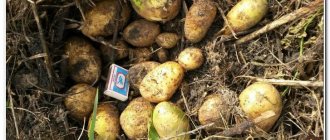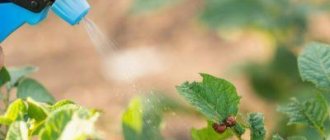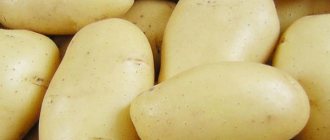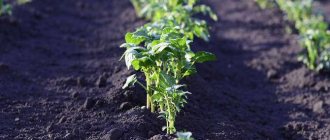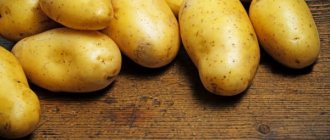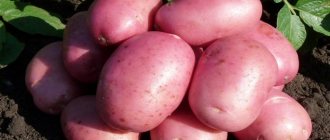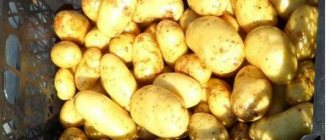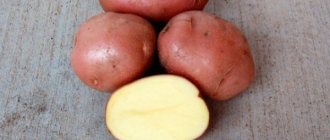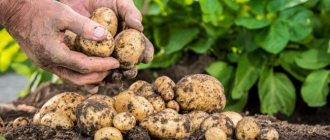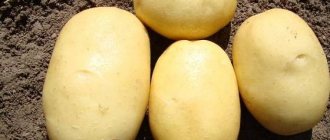How it was bred
These potatoes were brought to Russia from Germany. It was bred by one of the German breeders relatively recently. “Red Lady” was included in the state register of varieties of the Russian Federation in 2008. Its originator is the German company Norira GMBH. Further in the article we will look in detail at what “red lady” potatoes are (variety description, photos, reviews).
Description of tubers
Red lady potatoes have red skin color. The pulp of table varieties is usually white. Yellow varieties of potatoes were previously considered fodder. At least Soviet breeders once bred such tubers exclusively for pig farms. However, now many table varieties have appeared that have yellow flesh. The “red lady” also belongs to them. Judging by the reviews, the taste of its tubers is simply excellent. The pulp contains about 12.5-16.8% starch.
The size of potatoes of this variety is quite large. One tuber can weigh on average 114-142 grams. The shape of the “red lady” potato is neat, even, slightly elongated. The skin of the tubers is reticulate, flaky, and the eyes are superficial.
Characteristics of the variety
The potato variety in question has the following characteristic features:
- early ripening variety - sowing and appearance of the first harvest are separated by 60–80 days;
- the variety has an extended vegetative period: the tubers are stored after 3 months;
- plants are medium-sized, erect or semi-erect;
- crop yield - from 160 to 340 c/ha;
- up to 16 potatoes are formed under each plant;
- oval potatoes, quite large in size, each weighing 155 g; few small non-marketable tubers;
- tubers with reddish skin, light yellowish when cut;
- there is a compacted skin that protects the fruits from mechanical damage, making it possible to transport and store potatoes without loss of commercial quality;
- potatoes have a small number of superficial eyes, which makes the tubers easy to peel;
- starch content - from 12 to 17%;
- Thanks to its high taste, a variety of dishes can be prepared from this potato.
Reviews
“Red Lady” potatoes (variety description, photos, reviews from farmers fully confirm this) are a fairly productive crop. Its tubers look really neat and appetizing. In addition, summer residents and farmers include among the undoubted advantages of the “red lady”:
- resistance of bushes to drought;
- suitability for long-term storage;
- resistance to such common diseases as rust, scab, late blight, blackleg, rot.
Thus, we can assume that “red lady” (potatoes) has very good characteristics. Reviews about it are mostly good.
Among the advantages of this potato, many summer residents, among other things, include the fact that its tubers do not darken after heat treatment. In addition, black spots never form inside them. Potatoes of this variety are also resistant to various types of mechanical damage. All this, of course, can also be attributed to the unconditional advantages of the variety.
Yield reviews
In this regard, the opinion of summer residents about the “red lady” is also quite good. According to the manufacturer, up to 14 tubers can grow under just one potato bush of this variety. In general, reviews from summer residents confirm this fact. The yield of the “red lady” is really quite good. The advantages of this potato, many owners of country plots include the fact that in the bushes it practically does not produce small tubers. All potatoes are approximately the same size.
As stated it is 167-298 c/ha. And this figure is quite comparable with the indicators of the best domestic varieties (in particular, the standard “luck”).
Planting dates for the “red lady” variety
So, above we have discussed in some detail what “red lady” potatoes are (variety description, photos, reviews from summer residents). Next, let's look at how to properly grow this variety. The technology for cultivating this potato is similar to the methods for growing any other early ripening potato. The timing of planting “red lady” depends on the climatic conditions of a particular region. In Kuban, for example, this is early to mid-March. In the Urals and Siberia, potatoes are planted in May. In any case, the soil in the area for this crop should warm up well and not dry out.
Pros and cons of selection
- Pros:
- early ripening and extended vegetative period;
- can be used in industrial and amateur cultivation;
- ready-made dishes from the described potatoes have an excellent taste;
- high resistance to many diseases;
- high content of valuable substances;
- The collected products have good shelf life and are well preserved during long-term transportation.
- Minuses:
- susceptibility to late blight;
- root tubers are picky about the soil composition and its fertility;
- needs long daylight hours for successful growth and fruiting.
Did you know? The most expensive potato in the world is considered to be the La Bonnotte variety, which is grown on the island of Noirmoutier. Its cost reaches 500 euros per 1 kg.
Germination
Red Lady tubers, as already mentioned, can be dug up approximately on the 75th day after planting. To get the harvest even earlier, it is advisable to pre-germinate potatoes of this variety. This procedure is performed as follows:
- tubers are sorted;
- the selected potatoes are placed in a ventilated room at an air temperature of 8-12 C.
To ensure that the Red Lady tubers sprout evenly, they are periodically turned over during the germination process. In total, the potatoes should lie in a cool room for about 45 days.
Selecting a location
"Red Lady" - a potato whose characteristics allow us to judge it as quite unpretentious - can produce good yields in almost any plot. But some points are still worth taking into account when choosing a site for it.
Dacha plots in our country are usually not very large. Therefore, gardeners often grow potatoes in the same place year after year. “Red Lady” can produce good harvests even with this method of cultivation. But, unfortunately, only the first few years. In the future, this variety, like any other, will most likely have to be replaced due to degeneration.
To obtain good harvests of “red lady” for many years, its planting sites should be changed periodically. The best predecessors for these potatoes are cabbage and cucumbers. Under no circumstances should you plant “red lady” after tomatoes, eggplants and peppers.
The Red Lady potato variety likes soil that is loose and quite nutritious. Therefore, the site chosen for it should be fertilized with manure or humus in the fall.
Diseases and pests
Red Lady potatoes, judging from the description of the variety, have strong immunity to many diseases, but are very sensitive to late blight.
Late blight is a dangerous fungal disease that often affects potato tubers. The fungus develops intensively in rainy and warm weather. The first signs of the disease:
- dark spots appear on the leaves;
- the tops become brown and dry out over time.
Advice! To prevent the disease, it is necessary to grow potatoes after mustard.
When the disease appears, the bushes are treated with Agat or Ridomil solutions.
If the care rules are not followed, Red Lady, like other potato varieties, may develop:
- Leaf chlorosis. The disease can be detected by the foliage; it turns yellow with pronounced green veins. You can get rid of the disease by treating the plant with copper sulfate.
- Black scab. When the disease occurs, the growth and development of the plant stops.
- Brown bacterial rot. This disease affects tubers. The disease manifests itself during the flowering period. The leaves turn yellow, wrinkle and wither.
The most common pests are Colorado potato beetles. They often appear on crops grown in regions with warm climates. The pest is dangerous to crops for several reasons:
- due to great gluttony, the bushes completely disappear in a short time;
- the beetle is very tenacious, it is not afraid of the cold, insects are capable of falling into suspended animation and hibernate underground;
- fly from plant to plant;
- quickly get used to insecticides.
Landing technology
The tubers of this potato are usually placed on the field according to a pattern of 25 x 50 cm. “Red Lady” ripens early. His bushes are quite compact. Therefore, it is not necessary to leave too much distance between plants. The planting depth of tubers of this variety should be 5-6 cm. If the potatoes have not been germinated, this figure should be increased to 8-10 cm.
Plant red lady tubers in the holes. A little manure and ash are first poured into each.
How to harvest and store crops
3 weeks after the tops dry, the potatoes are dug up. They use manual labor (shovel, pitchfork), cultivator.
The dug up tubers are left in the sun for 5-6 hours for disinfection. If the soil was wet and soil remained on the root crops, gently shake it off. Potatoes are sorted into seeds and food. Sick tubers are destroyed.
The harvest is laid out in prepared containers (boxes, baskets) and lowered into the cellar. The vegetable storage area is ventilated, dried, and treated against fungi.
Important! In a cool, dry room, Lady potatoes remain fresh for 8-10 months - this is its advantage over other early varieties.
Hilling
Red Lady potatoes ripen early, but this procedure will still have to be carried out in the field. Like any other early ripening variety, this variety must be loosened once and hilled once per season. The second procedure is considered mandatory. It has been proven that hilling helps increase potato yields by about 1.5 times.
This procedure is carried out with a hoe in rows, being careful not to damage the tubers. At the same time, weeds are removed from the field. For the first time, the “red lady” should be loosened after the seedlings grow to 8-10 cm. The planting is earthed up when this figure reaches 13-16 cm.
Rules of care
Caring for Lady Claire potato seedlings is not difficult at all. The procedures are no different from those that must be carried out for almost any variety of such a vegetable.
The main item on the list is weeding. Timely removal of weeds helps root crops receive the maximum of nutrients and nutrients from the soil. This procedure also prevents the emergence and spread of pests. Loosening the soil must be done before planting seeds and as necessary during the development of the plant, but this is not necessary. As soon as the bushes grow by about 10-15 cm, they need to be hilled
This will help retain moisture in the soil to nourish the plant's root system.
It is important not to allow the soil to dry out, but you should not over-water it. Excessive amounts of moisture will lead to the appearance of fungal diseases in the root crop, so you need to water the soil only when necessary
In some regions it rains regularly, which means you don’t have to water the plants yourself at all. But don't forget about mulching. This procedure will allow moisture to remain in the ground longer, and this is extremely beneficial for the future harvest. Fertilizing the soil is also carried out if necessary. Organic matter, potassium and phosphorus are used as fertilizers. It is not recommended to use substances that contain nitrogen, as this can harm the crop. Also, systematically spray plants with compounds to prevent the spread of viruses and pests.
You will learn more about how to grow this potato variety in the following video.
Watering potatoes
The Red Lady potato variety has earned good reviews from summer residents for its drought resistance. However, of course, you should not allow the soil to dry out in the area with this crop. Otherwise, you will not be able to get a good harvest of this crop. The first time the potatoes should be watered when the soil is dry about 8 cm deep. The soil in the field should also be moistened when the plants are flowering. The plot should be watered in such a way that one bush receives about 3-4 liters of water. The soil should be saturated with moisture to about 20 cm.
Potato disease resistance
The Red Lady potato variety is resistant to most diseases. This:
- scab,
- fusarium,
- potato cancer,
- golden potato nematode,
- rot,
- blackleg.
But it is not immune to late blight, which affects the tops of the plant.
Late blight on potatoes
Preventive treatment of the crop with special preparations is necessary. The folk method of fighting fungus has proven itself well.
Spray the plant with whey and iodine once a week. To do this, add 20 drops of iodine to 2 liters of whey and dissolve everything in 10 liters of water. The solution is ready for use. Treat plants in the morning or evening hours.
Do I need to feed
Treating Red Lady potatoes with nutritional compounds should begin at the stage of sprout formation. During germination, in order to obtain a good harvest in the future, the tubers need to be irrigated with a solution containing a large amount of microelements - zinc sulfate, copper sulfate, boric acid, manganese. The concentration of such substances in the composition should be approximately 0.02-0.05%.
Tubers are treated during germination approximately once a week. At the same time, 5-6 liters of solution are consumed per 100 kg of potatoes.
A special feature of the “Red Lady” variety is that it absorbs the maximum amount of nutrients from the soil in the first stages of tuber development. Therefore, in the second growing season, it is advisable to additionally fertilize the field. In this case, you need to use phosphorus compounds.
Features of planting and growing
The culture is unpretentious; both an experienced gardener and a beginner can grow it.
Preparing for landing
They start planting potatoes when the soil temperature reaches +10°C - there is no need to rush to plant earlier, otherwise you can ruin all the seed.
Preparations for planting begin a month in advance. To obtain seedlings, only germinated seed material is planted.
The weight of potato tubers intended for sowing should be 70-100 g. Potatoes are carefully inspected for visible defects, leaving only intact ones.
Germinate the seed in a bright room at a temperature of at least +15°C. The greening of tubers during germination indicates an increased content of toxic solanine in the skin. When planting, this will protect the tubers from many pests.
Reference. Solanine is a poisonous glycoside that is produced in plants of the nightshade family. It is especially dangerous for rodents, so field mice avoid such plantings.
Before sowing, the tubers are treated with growth stimulants “Kornevin” or “Bioglobin”.
Soil requirements
For rapid germination, potatoes require loose, fertile soil. Therefore, the soil is dug up twice with the addition of humus and wood ash. The second not only saturates the earth with useful elements, but also prevents the proliferation of fungi. The soil is dug up in the fall after harvesting and in the spring before sowing.
For lightness, fine river sand is added to the soil, which acts as a loosening agent. If the soil is highly acidic, adding dolomite flour or slaked lime will help deacidify it.
Reference. The acidity of the soil is increased if horse sorrel, blueberries, and lupine grow on the site.
Timing, scheme and technology of planting
Potatoes are planted when the ground warms up to +10°C and the threat of return frosts has passed. The crop does not tolerate sudden cold weather - it negatively affects its growth. Therefore, sowing work is carried out from the last days of April to the end of May, depending on the climatic characteristics of the region.
When planting, leave 35 cm between seedlings, 55-65 cm between rows. The depth of the holes is no more than 10 cm. The tubers are planted with sprouts facing up and sprinkled with wood ash. Then they sprinkle the soil on top, compact it, water it and mulch it - for this they use sawdust or straw.
Reference. Mulch protects crops from penetration of ground pests into the holes and retains moisture in the beds.
Nuances of care
Further care consists of watering, weeding, hilling and fertilizing.
Watering mode
Due to its resistance to heat, the Red Lady variety does not require abundant watering. Only during flowering and tuber formation will the seedlings need more water: during this period, at least 3 liters of water is poured under each of them. During dry weather, mulching will keep the beds moist and prevent evaporation.
Feeding
For full development and a rich harvest, potatoes are fed at least three times.
Two weeks after germination, the first fertilizing with urea is performed. Dissolve 500 g of urea in 10 liters of water and pour 0.5 liters under each bush. If the growth of seedlings is poor, at the initial stage they are fertilized with nitrogenous substances, accelerating their growth.
Before flowering, the plant is fed with a full range of minerals with a predominant content of phosphorus.
The third feeding is carried out three weeks before harvest. 30 g of superphosphate and 250 g of slurry are dissolved in a bucket of water.
Weeding and hilling
It is most convenient to weed the beds on damp soil. After removing the weeds, the soil is loosened, improving its breathability.
Hilling is carried out at least twice per season. Thanks to this procedure, the yield of the crop increases, as it stimulates the formation of new roots. Hilling up seedlings is not difficult; to do this, the soil from the rows is raked into the beds with a hoe.
Reference. High hilling prevents ground insect pests from penetrating the roots.
Disease and pest control
Late blight is a common fungal disease that often affects plants of the nightshade family. It destroys green mass and tubers. The fungus spreads quickly in conditions of high humidity and temperature. Therefore, it is recommended to treat watering wisely. The disease is difficult to cure, so prevention begins immediately after sowing.
Wood ash, which is sprinkled on the seed, protects the tubers until germination. Then the two-week-old seedlings are sprayed with the fungicide “Fitosporin”. The drug is known to most gardeners as reliable protection against fungal diseases. Spraying is carried out systematically, but not more than once a month.
Brown bacterial rot, also a fungus, occurs due to improper care. The highest period of activity occurs at the time of flowering. Following the rules of crop rotation and introducing timely fertilizing will help prevent brown rot from appearing in the beds, thanks to which the plants’ immunity will be strengthened.
The most dangerous pest is the Colorado potato beetle. They destroy crops with lightning speed. The pest is not afraid of cold weather; it successfully survives it underground.
When the number of beetles is small, they are collected manually, carefully inspecting the seedlings from all sides. If there are a lot of them, insecticides are used - for example, Confidor.
